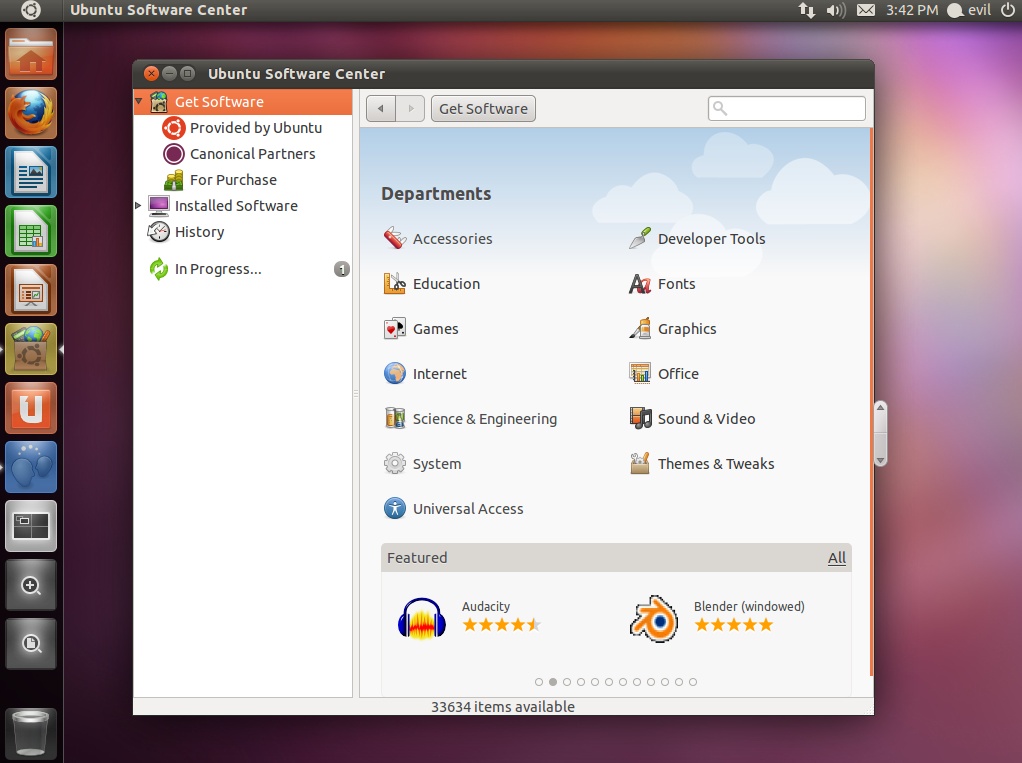Ubuntu 11.04 Released
How time flies! Every six months, Ubuntu releases the next iteration of their popular desktop Linux distribution, and today is just such a day. Ubuntu has officially released version 11.04 "Natty Narwhal". There are thousands of package updates in this release, but what follows are some of the more notable items.
Desktop:
The default desktop environment for Ubuntu is now the Unity Desktop.

Should you not care for the Unity interface, the “classic” Ubuntu desktop interface can be selected from the login menu.
The Unity Dash now allows you to quickly search through your applications. Not only does a single keypress allow you to start searching for applications you have installed, but it will even suggest possible matches that you do not have installed (and a single click will then take you to the description/installation screen in the software center!)

A new style of scrollbar has been introduced for both the Unity and Gnome Shell desktops. The new scrollbars take up less space and dynamically appear as you approach their area. This gives more space for actual content, while giving the controls a static size that is easy to use on portable devices.
Due to the tablet/netbook friendly GUI of Unity, Canonical has dropped the netbook edition of Ubuntu. The one interface has been conceive to work for all devices.
Music/Audio:
- Rythmbox had a good run, but has been replaced by the more popular Banshee music player.
- Better support for iPhones in Nautilus.
- Media playback has been integrated into the volume control

Office and Productivity:
As mentioned in a previous HotHardware news article, OpenOffice has been replaced by LibreOffice as the default office suite.
The Software Center has been improved and now has WebLive support. This allows you to "Test Drive" many applications without installing them. Clicking the "Test Drive" application connects you to an instance of the application via an NX session on a remote server.
On the anti-productivity front, unless you really use the web for work, the default web browser Firefox has been updated to version 4. Work has also been done to integrate it with the rest of the desktop environment in a more seamless fashion.
Synchronization and
Cloud support:
Ubuntu One has seen a bit of work since 10.10. It now sports a much nicer interface and is cross platform.

Ubuntu One allows you to synchronize music, folders, and bookmarks across multiple systems, even with Windows, Android, and iPhone devices. Music bought through Ubuntu One's store is backed up in the cloud and accessible from any of your other Ubuntu One devices.
Music from the Ubuntu One Music Store does not count against your Ubuntu One storage limit (First 2GB free, $3/mo for every 20GB greater than that).
Ubuntu Server Cloud has improved OVF support, as well as dynamic resizing/renaming upon first boot.
Social Networking:
If you so desire, you can set up broadcast accounts to send broadcasts to Twitter, Facebook and other services directly from the desktop.
 |
 |

Kernel Updates:
Ubuntu is now using the 2.6.38 version of the Linux kernel. The 20,000+ updates since the kernel in Ubuntu 10.10 offer several advances. Some of the highlights include:
- Increases desktop performance. This includes the “wonder patch” that gained attention for allowing the desktop to get a better share of system resources when the system is highly utilized by processes in other control groups..
- VFS (Virtual File System – communications between the kernel and user space) optimizations. The VFS is now 30-50% faster on some operations.
- Improves support for popular video chipsets and adds support for newer hardware. Specific items include support for Bobcat APUs, Radeon 6200, 6800, & 6900 family GPUs, and better power handling for i3, i5, and i7-2000 APUs.
- Many driver improvements, including better support for wireless LAN drivers for chips from Atheros, Broadcom, Intel, Ralink and Realtek.
- Fixes suspend/resume issues for some hardware;.
- Improvements to Ext3, Btrfs, SquashFS, UDF and XFS file system performance.
For those not interested in the Unity or Gnome desktop environments, several derivative versions should also be celebrating releases today. These use the same repositories as Ubuntu, but have varying desktop environments and default packages.
Kubuntu : Uses the KDE4.6.2 Desktop Environment.
Xubuntu : An official version of Ubuntu that uses the XFCE Desktop Environment.
Edubuntu : An Ubuntu distro with heavy emphasis on educational software packages.
Users already running Ubuntu or a derivative may upgrade directly from their existing install. Users interested in trying Ubuntu for the first time can download a LiveCD from the main site and try it without installing anything to the hard drive.

